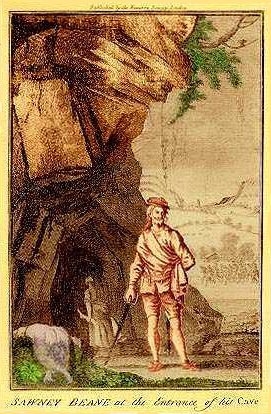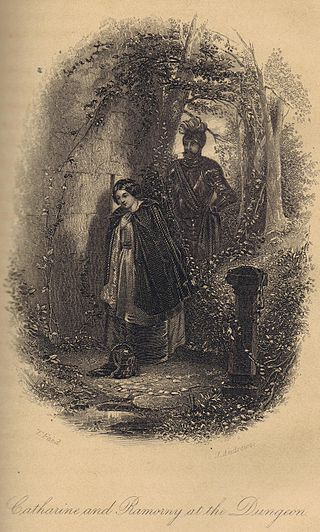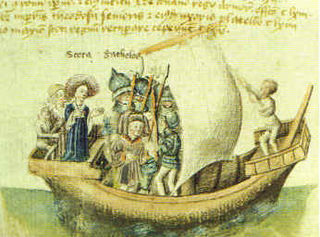
Alexander III was King of Scots from 1249 until his death. He concluded the Treaty of Perth, by which Scotland acquired sovereignty over the Western Isles and the Isle of Man. His heir, Margaret, Maid of Norway, died before she could be crowned.
Áed mac Cináeda was a son of Cináed mac Ailpín. He became king of the Picts in 877, when he succeeded his brother Constantín mac Cináeda. He was nicknamed Áed of the White Flowers, the wing-footed or the white-foot.

Máel Coluim mac Cináeda was King of Alba (Scotland) from 1005 until his death in the year 1034. He was one of the longest-reigning Scottish kings of that period.
Andrew Wyntoun, known as Andrew of Wyntoun, was a Scottish poet, a canon and prior of Loch Leven on St Serf's Inch and, later, a canon of St. Andrews.

Alexander "Sawney" Bean is a legendary figure, said to be have been the head of a 45-member clan in Scotland in the 16th century that murdered and cannibalised over 1,000 people in 25 years. According to the legend, Bean and his clan members were eventually caught by a search party sent by King James VI and executed for their heinous crimes.
The Pictish Chronicle is a name used to refer to a pseudo-historical account of the kings of the Picts beginning many thousand years before history was recorded in Pictavia and ending after Pictavia had been enveloped by Scotland.
Fothad II was the bishop of St Andrews (1059–1093) for most of the reign of King Máel Coluim III mac Donnchada. Alternative spellings include Fodhoch, Fothach and Foderoch, and Fothawch. A "Modach filius Malmykel" is mentioned in a grant, dated 1093, as the bishop of S. Andrews. As this bishop is certainly Fothad II, his father was a man named Máel Míchéil.
Máel Ísu I is the third alleged Bishop of Cennrígmonaid, equivalent to latter day St Andrews. He is mentioned in the bishop-lists of the 15th-century historians Walter Bower (Malisius) and Andrew of Wyntoun (Malice) as the successor of Fothad I, and it is claimed that he reigned as bishop for eight years. If Máel Ísu's predecessor did get expelled from the bishopric in 955,, and if Máel Ísu's reign really was eight years, then Máel Ísu would have held the bishopric between the years 955 and 963.
Cellach II is the fourth alleged Bishop of the Scots, the predecessor of the later St Andrews bishopric.
Máel Dúin is the eighth alleged Bishop of St Andrews. He is mentioned in the bishop-lists of the 15th-century historians Walter Bower and Andrew of Wyntoun as the successor of Bishop Ailín.

The Fair Maid of Perth is an 1828 novel by Sir Walter Scott, one of the Waverley novels. Inspired by the strange, but historically true, story of the Battle of the North Inch, it is set in Perth and other parts of Scotland around 1400.
Cannibalism, the act of eating human flesh, is a recurring theme in popular culture, especially within the horror genre, and has been featured in a range of media that includes film, television, literature, music and video games. Cannibalism has been featured in various forms of media as far back as Greek mythology. The frequency of this theme has led to cannibal films becoming a notable subgenre of horror films. The subject has been portrayed in various different ways and is occasionally normalized. The act may also be used in media as a means of survival, an accidental misfortune, or an accompaniment to murder. Examples of prominent artists who have worked with the topic of cannibalism include William Shakespeare, Voltaire, Bret Easton Ellis, and Herschell Gordon Lewis.
The Prior of Loch Leven was the head of lands and of the community Augustinian canons of St Serf's Inch Priory, Loch Leven. There was a Scottish Céli Dé establishment there in the first half of the 12th century, allegedly found by Bruide, son of Dargart, King of the Picts (696–706). When the Augustinian priory was founded in 1150, the Scottish monks were absorbed into the established and those who refused to join were to be expelled. Not all of the priors are known. The most famous prior undoubtedly was the chronicler, Andrew de Wyntoun. Following more than four centuries of Augustinian monastic life and the resignation of the last prior, the Protestant king, James VI of Scotland, granted the priory to St Leonard's College, St Andrews.

St Serf's Inch or St Serf's Island is an island in Loch Leven, in south-eastern Perth and Kinross, Scotland. It was the home of a Culdee and then an Augustinian monastic community, St Serf's Inch Priory.

The Battle of the North Inch was a staged battle between the Clan Chattan and the "Clan Quhele" in September 1396. Thirty men were selected to represent each side in front of spectators, including King Robert III of Scotland and his court, on land that is now the North Inch park in Perth, Scotland.
Anti-Scottish sentiment is disdain, discrimination, or hatred for Scotland, the Scots or Scottish culture. It may also include the persecution or oppression of the Scottish people as an ethnic group, or nation. It can also be referred to as Scotophobia or Albaphobia.

The Scotichronicon is a 15th-century chronicle by the Scottish historian Walter Bower. It is a continuation of historian-priest John of Fordun's earlier work Chronica Gentis Scotorum beginning with the founding of Ireland and thereby Scotland by Scota with Goídel Glas.

Holinshed's Chronicles, also known as Holinshed's Chronicles of England, Scotland, and Ireland, is a collaborative work published in several volumes and two editions, the first edition in 1577, and the second in 1587. It was a large, comprehensive description of British history published in three volumes.
Jim MacCool is a British dramatic poet in the shanachie or travelling bard tradition. MacCool is the author of Ionan Tales, a series of twelve lengthy tales in verse inspired by the Canterbury Tales and which he has performed more than a thousand times in places from Brisbane to Chicago since their premiere at a Sunday Times–sponsored Literary Festival at the 2000 Millennium. His shows typically combine his singing of Irish or Scots folk ballads, such as "The Belle of Belfast City" or "Whiskey in the Jar", a poetic recitation and a Celtic drum performance. MacCool is the founder and patron of Britain's National Poetry Month and in August 2006 was named poet-in-residence for Dudley, West Midlands.
In July 1482 an English army invaded Scotland during the Anglo-Scottish Wars. The town of Berwick-upon-Tweed and its castle were captured and the English army briefly occupied Edinburgh. These events followed the signing of the Treaty of Fotheringhay, 11 June 1482, in which Alexander Stewart, Duke of Albany, the brother of James III of Scotland declared himself King of Scotland and swore loyalty to Edward IV of England. The follow-up invasion of Scotland under the command of Edward's brother, Richard, Duke of Gloucester failed to install Albany on the throne, but Berwick has remained English ever since the castle surrendered on 24 August. The English army left Edinburgh with a promise for the repayment of the dowry paid for the marriage of Princess Cecily of England to the Scottish Prince.







